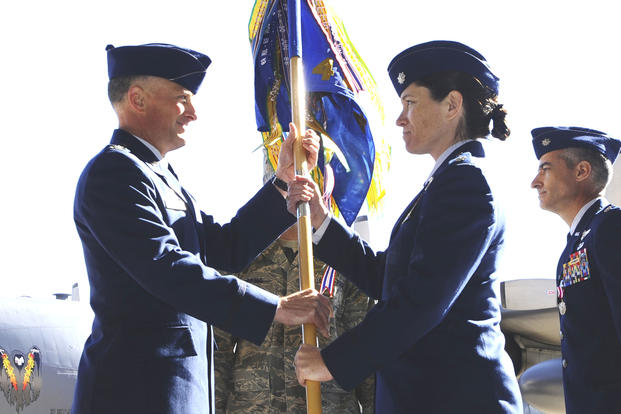HURLBURT FIELD, Fla. -- In another milestone for women in the military, Air Force Special Operations Command will soon have its first female air commando brigadier general, who will become the command's director of operations, according to Lt. Gen. Brad Webb, commander of AFSOC.
Col. Brenda Cartier, currently commander of the 58th Special Operations Wing at Kirtland Air Force Base, New Mexico, will transition to Hurlburt in the summer.
"We have a vice wing commander who's female now, several group commanders. I can't tell you how many squadron commanders -- that should tell you something -- there's a lot. We're in the double digits of chief master sergeants and first sergeants on the enlisted side in AFSOC," Webb said.
None of this was in the Air Force's vision even 20 years ago, he said.
Related content:
- 6th Woman in Battlefield Airman Training Drops Out
- SpecOps, CSAR Alignment Right if it Makes Force More Lethal: General
- Air Force Secretary: 'Our Doors Have to Be Open to All'
During a trip to AFSOC earlier this month, Air Force Secretary Heather Wilson and other service leaders spoke to Military.com about the strides the service has made in opening roles and career fields fully to women.
Wilson said she could recall exactly where she was when she saw a woman wearing pilot wings for the first time.
"I was a cadet. I was at the base of the ramp at the Air Force Academy. I walked by, saluted her -- I was on my way to the cadet clinic -- and said, 'Ma'am, can I ask you a question?' It was something completely stupid like, 'Where'd you get those?' " Wilson said.
"But I had been in the Air Force six years before I saw a full colonel who was a woman. I didn't feel limited in what I could be. But the fact that I noticed that when I saw it told me that young people need role models," she told Military.com during an interview here May 4.
It's a moment that's stuck with her not only in her Air Force career, but throughout her journey as a leader, serving in Congress and as president of a science and engineering university in South Dakota.
In recent months, Wilson has often said it is natural to think of women as protectors. That outlook may speak to why serving in the military is a natural fit.
But the message may not be enough, she said.
"People have heard that from me. I'm not sure that will change things significantly in any short-term time in the way we recruit, but [there are] tremendously talented young women, girls who can make huge contributions," Wilson said.
If being seen as a protector doesn't speak to young girls, perhaps another viewpoint can.
For months, the service has touted its stance on innovation, that breaking technological barriers will help the Air Force advance in the next high-end fight.
For women contemplating the service or those who wish to challenge themselves in a new career field, a similar message resonates: You can break barriers too.
"Twenty percent of the Air Force is women, which is still the highest of any service, although probably still too low for the talent that's available," Wilson said.
Wilson herself graduated from the Air Force Academy in 1982, part of the third class to include women. She is the third woman to serve as Air Force secretary.
"What matters is the ability to do the mission," she said.
Wilson said women moving up the ranks matters to future generations looking to lead.
For example, in 1967, women were allowed to hold rank above lieutenant colonel outside administrative support jobs. In 1973, ROTC opened to women. Three years later, the Air Force Academy granted admission to women, and pilot training was extended to those who wanted to fly.
Still, women could not fly combat aircraft until 1991.
"There was a group of women, including me, who went to Congress to help … change that law," Wilson said. "The change to that law really meant 99.9 percent of positions were open to women."
Fast forward to 2015 when then-Defense Secretary Ash Carter announced that all military occupational specialties would open to women, including battlefield airman specialties.
And while the service to date has not been able to graduate a female airman in a special tactics or battlefield airman role, it is weighing how it can better "target those likely to pass in addition to those already coming forward," Webb said.
If the service readily recognizes potential, progression will become more natural, he said.
"[Let's] talk about it. There's some preparation that has to have been done mentally as well as physically to get [into the battlefield pipeline], but it can certainly be done, and it will, and it will be naturalized," Webb said.
The Air Force knows new potential female recruits and future leaders are out there. It's just a matter of time before they come forward, Wilson added.
"Are we changing the way in which we recruit? We know there are highly talented women who may have not thought of themselves as airmen" yet, she said. "I think that sometimes some of our recruiting material appeals more to boys that to girls. If you ask an aircrew, 'When did you first think of flying?' Most boys [will answer] it's in elementary school or middle school. Most girls and also minorities? It's in college."
She continued, "They get enamored with this idea later. And it may be who's talking to them about what it's OK to be, what it's OK to dream.
"We need to recognize that this decision happens later. And some of that is seeing women in those roles," Wilson said.
-- Oriana Pawlyk can be reached at oriana.pawlyk@military.com. Follow her on Twitter at @Oriana0214.













